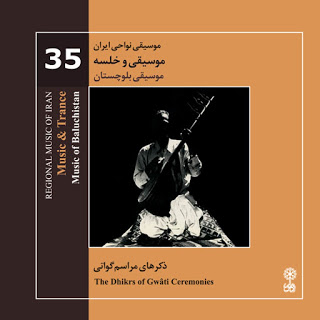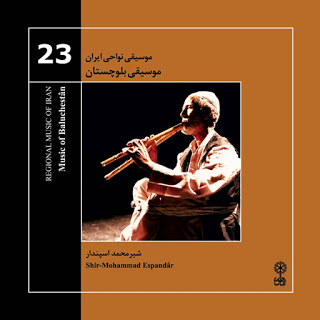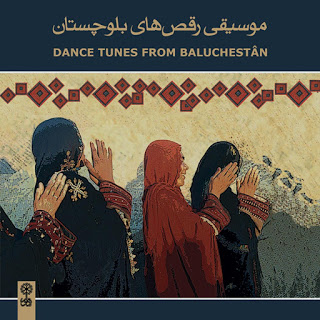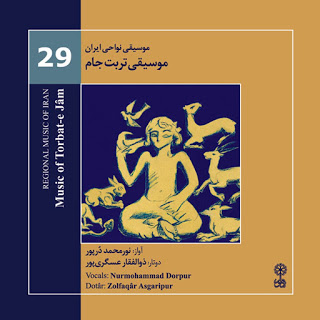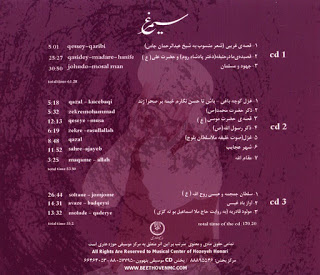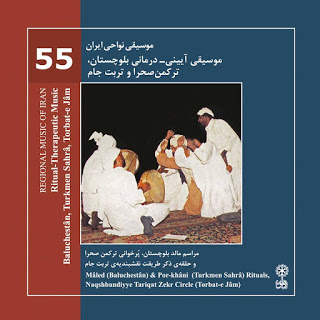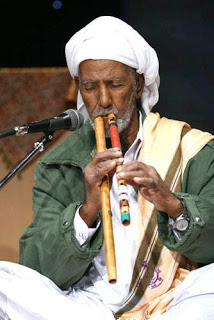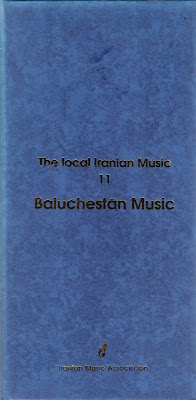
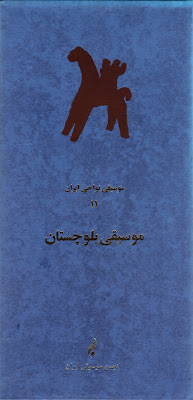
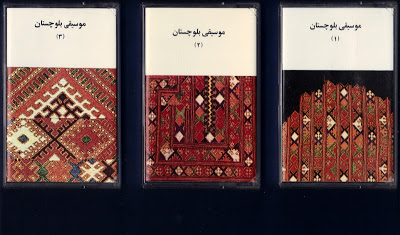
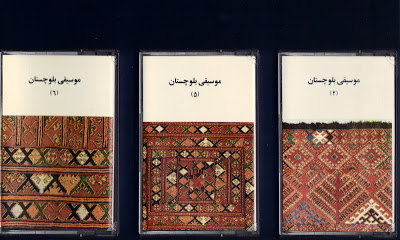
"The Local Iranian Music" was the first big project of documenting local or regional music of Iran. It consisted of about 18 albums, each containing six cassettes and a booklet in Farsi. The volumes could be bought individually (
info@raga-maqam-dastgah.com still has a few in stock) or all together in a big wooden box. Today there are several other series devoted to this subject available on CD, partly as an ongoing work in progress like the series "Regional Music of Iran", of which up to now 63 volumes have been published, partly consisting of several CDs. These were published by the label MAHOOR. Others are live recordings from festivals devoted to regional music of Iran and have up to over 20 volumes. Most of these have been published on CDs and can be obtained from:
info@raga-maqam-dastgah.com. In the future we plan to post here one complete set published many years ago on 27 cassettes. The whole series was supposed to be re-published on CD a couple of years ago, but never saw the day.
One has to say that no other oriental country does such an exemplary work of documenting all aspects of their traditional music on hundreds of CDs and also in an enormous number of books, unfortunately - of course - all in Farsi.
Iran is especially rich in different forms of often highly sophisticated regional music, due to its position between Central Asia, Asia Minor, Arabia and the Indian subcontinent which led to a high ethnic diversity. In effect many of the 31 provinces of Iran have their own ethnic, cultural and musical identity.
I still remember very vividly an amazing huge Iran Festival taking place the whole of spring 1991 in Düsseldorf, Germany, with many fantastic concerts of regional and also classical music, exhibitions, conferences and a bazar of handicrafts, cassettes and books. Through this festival I encountered for the first time music from Khorasan, Baluchestan, Bakhtiari, Kurdestan, Iranian Azerbaijan etc. etc. I was extremely touched by the beauty of the music of the great Haj Ghorban Soleimani from Northern Khorasan, an ensemble from Bakhtiari, another ensemble from Torbat-e Jam in Eastern Khorasan near the border to Afghanistan and one from Baluchestan. There were also two impressive Ashiqs from Azerbaijan. It was a dream come true which one never even dared to dream. I bought there quite a number of cassettes. Only a few years before it started that one was able to get the first cassettes from Iran in some Iranian shops in Düsseldorf and Cologne. At this festival I was also able to buy a wonderful book in the form of an album of exquisite photos in which one was invited to travel through different provinces of Iran, starting in Persepolis and Shiraz going up to Azerbaijan and then along the western border through Kurdestan down to Bushehr and then along the Gulf coast to Baluchestan in the east, from there up through Bam and Yazd to central Iran, then to Eastern Khorasan and Northern Khorasan, Iranain Turkmenistan, Mazandaran and finally to Tehran (
N. Kasraian - Our Homeland Iran). So I was able to have a look at the regions from which the music came, which I had aquired. That was one of the most beautiful periods of musical discovery in my life.
Here we start now to post the only four volumes of this first project "The Local Iranian Music" we have kept in our collection as being musically the most interesting ones: three volumes of Music from Khorasan and the one volume of Music from Baluchestan. We start with Baluchestan.
"Balochistan, or Baluchistan, is an arid desert and
mountainous region in south-western Asia. It comprises the Pakistani province of
Balochistan, the Iranian province of Sistan and Baluchestan, and the southern
areas of the Afghan provinces of Nimruz, Helmand,
and Kandahar. Balochistan borders the Pashtun region to the north, Sindh to
the east, Punjab to the northeast, and Persian regions to the west. Across its
southern coastline lies the Gulf region." from Wikipedia.
"The repertoire of the music of Baluchistan could be divided into three
major categories: (a) artistic music, such as sowt, nazing, etc, and the most
important part of it, shervandi music, comprises of epic and zahirik music and
Sufi ghazals (always in persian), that could be classified as classical music;
(b) religious music inspired by Sufi doctrines, including zekrs and verds of
Qaderi and Refa'i dervishes and also repertoire of Cheshti dervishes; (c) music
of guati ceremonies or Qalandari-Guâti music.
Guati (or Qalandari-guati) music is specific to the ceremonies of healing
the person who is possessed by a supernatural being, and shows symptoms of
sickness. Baluchi people interpret the healing process as follows: a person
(most of the time a woman) becomes sick and all the efforts of the traditional
healer and mollah to cure her are in vain. Patient's relatives, after trying all
the possible ways of treatment - and becoming disappointed - take her to a
spirit expert (or khalife). These spirits are guats, djins and paries that
disturb people for some reasons and make them sick. If someone is possessed by
one of these creatures, the only solution is talking to guat and persuading him
to let the possessed person alone. In order to do that, a healing ceremony must
be held, where music plays an important role." Jean During in the booklet to: Regional Music of Iran 9 - Qalandari Music of Baluchistan, Mahoor, M.CD-181 (2005).
The music on these six cassettes here is all from the Iranian part of Baluchestan. By now there exist quite a number of CDs of this music, both from the Iranian and from the Pakistani part, most of them published in Iran. As always, they can be obtained from the link given above.
Cassette 1: Baluchestan Music - Iranshahr - Ostad Shir-Mohammad Espandar
Shir-Mohammad Espandar (Doneli & Vocal)
Jahangir Parvin (Sorud which is named Ghichak in Iran)
Mohammad Omar Sami (Benju)
Morid Zangeshahi (Tanbourak)
Nawab Rawhand (Dholak)
"Ostad Shir-Mohammad Espandar, son of Morad, was born in Bampur in 1927. His father was a Ney player and the style of Shir-Mohammad in Ney playing is obviously influenced by the style of his father. For more than fifty years he has been playing Donali and Nal (Ney). Shir-Mohammad also knows vocal Maqams as well as playing Donali; especially Kurdish song which he excels and has shown a peculiar skill in it. It must be added that presently he is the sole interpreter of Kurdish song in its original form. Shir-Mohammad immigrated to Indus (Send) Province of Pakistan and spent 15 years of his youth there. He had been familiar with Ney and played it before. In Pakistan he get acquainted with Donali and learned its playing under the tutelage of Jomal-Shah. In 1958 he returned home and since then he has resided in Bampur and spends by farming and music playing. He is the only survived Donali player in Baluchistan of Iran. His style in Donali playing is deeply affected by the great past masters, Jomal-Shah and Mersi-Khan. However, he has been able also to take advantage of traditional styles to create a unique expression in Baluchi music.
Shir-Mohammad has always been at the side of his fellow countrymen, either
in their happiness or in their sorrows; He accompanies the possessed ones, those
who consign their soul and their body to Gwat, and seek their freedom in the
songs Shir-Mohammad sings and in the music he plays. During a performance,
Shir-Mohammad reaches a trance, begins an inward journey and goes far beyond
himself, so far that he can see his today from outside and respond properly to
the music and to himself; Again and again he travels inward and returns back,
and it is during this ingress and egress, this upward and downward traveling,
that he experiences revelations, and an enchantment for reconciliation and
disengagement. The music of Shir-Mohammad results from this transcendental
relatedness and comes out from this connection."
from the booklet to the CD: Regional Music of Iran 23 - Music of Baluchistan - Shir-Mohammad Espandar, Mahoor, M.CD-051
(2000)
Cassette 2: Baluchestan Music
Side A: Barkat Shakalzahi (Vocal & Benju)
Side B: Ustad Musa Zangeshahi (Vocal & Rabab)
accompanied by:
Din Mohammad Zangeshahi (Sorud which is named Ghichak in Iran)
and players of Benju, Rabab, Tanbourak & Dholak
Cassette 3: Sowt Music - Baluchestan - Iranshahr
Mashallah Bameri (1950-2011) (Vocal) accompanied by:
Shir-Mohammad Espandar (Donali)
Jahangir Parvin (Sorud which is named Ghichak in Iran)
Mohammad Omar Sami (Benju)
Morid Zangeshahi (Tanbourak)
Nawab Rawhand (Dholak)
Cassette 4: Baluchestan Music
Volume 4 contains outdoor music as it is performed at festive events like weddings, circumcisions etc. It is performed on Zurnas accompanied by two Dohols in different sizes. This is a music which exists in similar forms in all the regions of Iran.
Cassette 5: Baluchestan Music
Side A:
Ustad Musa Zangeshahi (Vocal & Rabab)
Side B:
Tracks 1 - 3: different singers
Tracks 4 - 6:
Ustad Musa Zangeshahi (Vocal & Rabab)
On both sides accompanied by:
Din Mohammad Zangeshahi (Sorud which is named Ghichak in Iran)
and players of Benju, Rabab, Tanbourak & Dholak
Cassette 6: Baluchestan Music
Side A:
Ustad Musa Zangeshahi (Vocal & Rabab)
Side B:
Track 1: Faiz Mohammad ...
Track 2: Barkat Shakalzahi (Vocal & Benju)
Track 3: instrumental
On both sides accompanied by:
Din Mohammad Zangeshahi (Sorud which is named Ghichak in Iran)
and players of Benju, Rabab, Tanbourak & Dholak
